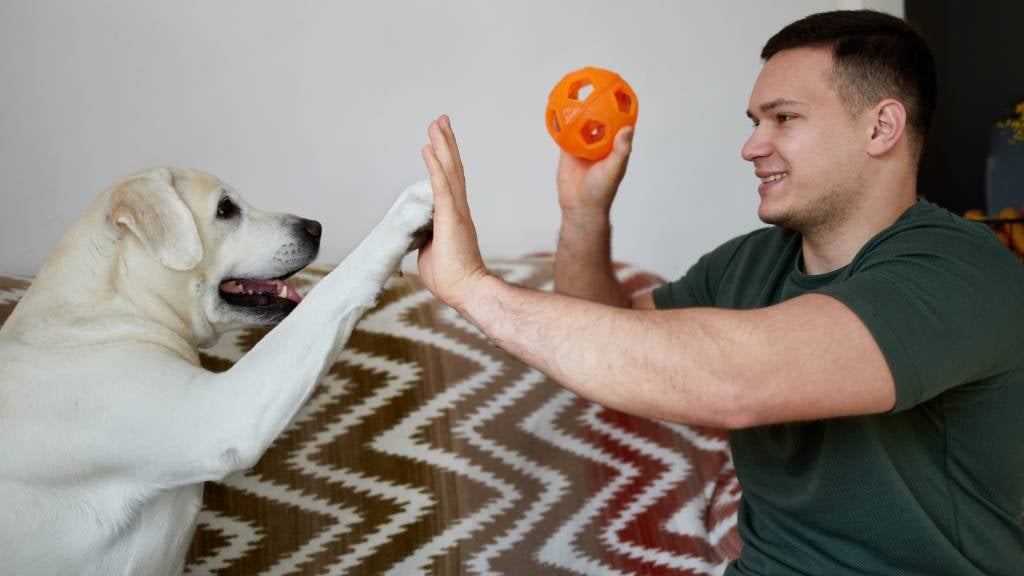Quick take
- Dogs need brain workouts as much as walks – boredom can fuel chewing, digging and barking
- Short, daily enrichment sessions lift focus and confidence
- Rotate toys and difficulty levels to keep things fresh
- Reward calm, thoughtful behaviour – not frantic guessing
- Match activities to your dog’s age, breed and energy
Why mental stimulation matters
Many dogs thrive when their bodies and brains get a workout. Without enough challenge, many dogs get restless or anxious, which can show up as chewing, digging or even barking. Simple enrichment games build problem-solving skills, reduce stress and strengthen your buddy bond.
7 activities to keep your dog mentally stimulated
1. Puzzle toys and treat dispensers
- Use stuffable toys, snuffle mats or food-dispensing balls
- Start easy, then increase difficulty to keep your dog engaged
- Great for slowing fast eaters while adding a brain boost
2. Hide and seek
- Hide treats or favourite toys around one room
- Release your dog to “find it” and cheer each discovery
- Builds search skills and confidence
3. Mini training sessions
- 5–10 minute bursts to teach cues or fun tricks
- Mix obedience with hand targets, spins or nose touches
- End on a win and keep it upbeat
4. Interactive games
- Tug with clear rules and a solid “drop it”
- Soft-fetch variations down a hallway for tight spaces
- Add simple obstacles like cushions for variety
5. Scent work
- Place a few treat pots or scented cotton pads around the room – avoid essential oils as they can prove toxic to dogs
- Let your dog search using their nose, not your pointing
- Increase the challenge by raising or hiding containers
6. Rotating toy library
- Keep 6–8 toys in a tub and rotate a few every couple of days
- Novelty keeps motivation high and extends toy lifespan
7. Enriched walks
- Sprinkle in training cues, slow sniff stops and new routes
- Try different textures – grass, paths, boardwalks – for sensory variety
Tips for successful mental stimulation
- Keep sessions short – 5 to 15 minutes is plenty
- Tailor difficulty to your dog and build up gradually
- Watch body language – if they seem stressed, simplify and reset
- Pay with food, praise or play when they make good choices
- Supervise new toys and games for safety
Benefits of regular mental enrichment
- Reduces destructive behaviour by channelling energy into problem-solving
- Helps manage boredom and separation stress
- Improves focus, resilience and learning
- Deepens your bond through shared wins
Final thoughts
A little brain work goes a long way. Mix one or two activities into your daily routine, rotate often and celebrate the small wins. You’ll have a calmer, more content mate who’s ready to snooze after thinking hard.
Keep playtime clever with Buddy
Rainy day, tiny flat or just a quieter week – smart games keep tails wagging. Buddy Pet Insurance has your back while you focus on training, treats and fun.
FAQsFrequently Asked Questions about mental stimulation for dogs
Indoor days happen – here are quick answers to keep brains busy the right way.
How long should enrichment sessions be?
Aim for 5–15 minutes, once or twice a day. Stop while your dog is still keen.
What if my dog gets frustrated with puzzles?
Make it easier: larger openings, softer fillings or simpler puzzles. Help them succeed, then slowly increase difficulty.
Can enrichment help with barking or chewing?
Yes – giving your dog a job redirects energy and reduces boredom behaviours when paired with exercise and routine.
Are sniffy walks really mental stimulation?
Absolutely. Sniffing is hard brain work and can be more tiring than a fast, distraction-heavy walk.
Which games are best for seniors or puppies?
Choose gentle, low-impact options – easy snuffle activities, slow training and short scent games tailored to their ability.
21 Nov 2025

